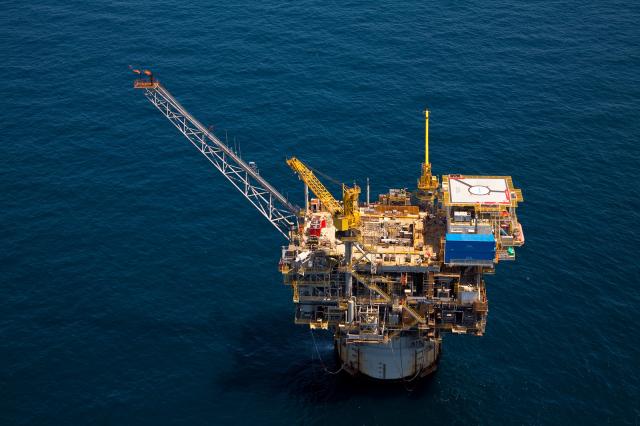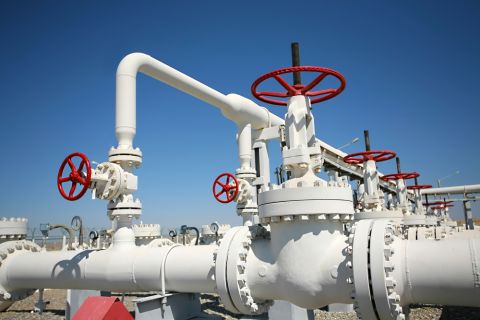
Anadarko’s 100%-owned Constitution spar in the Green Canyon area of the deepwater U.S. GoM will host production from the Constellation Field roughly 32 km (20 miles) away. (Source: Anadarko Petroleum Corp.)
Prolonged softness in commodities prices has made it a tough slog for operators and service companies alike in the U.S. Gulf of Mexico (GoM). Going on nine years removed from record oil prices topping $140/bbl, crude has maintained its value within a narrow band between $40/bbl and $60/bbl for the better part of the last 24 months. The effects of the commodities pinch forced some players into bankruptcy, like jackup contractor Hercules Offshore. Others turned to the mergers and acquisitions market to keep capital flowing in difficult times, such as Freeport-McMoran’s sale of its deep Gulf assets to Anadarko late last year. Anadarko paid $2 billion for an additional 80,000 net boe/d of U.S. GoM production.
A glance at the U.S. Bureau of Safety and Environment Enforcement’s Deepwater Activity report near April 1 found 22 floating mobile offshore drilling units active in the U.S. GoM, and only five of those rigs were drilling ahead on exploration wells. The current pricing environment isn’t one to encourage big swings at the fences or wildcatting for elephant fields. Activity in the shallow U.S. GoM is worse, with the lion’s share of the region’s jackup fleet out of work and stacked.
The primary exploration focus for operators drilling in the Gulf is on low-cost near-infrastructure opportunities that could lead to development scenarios using existing deepwater structures. Only a handful of standalone greenfield projects are being matured at this point, and those are being guided by the likes of supermajors BP and Shell. This spring BHP Billiton drilled a test of its Wilding prospect in the southeastern Green Canyon area, one of the hot spots for drilling activity in the deep U.S. GoM. Wilding in Block 521 was drilled using Transocean drillship Deepwater Invictus. If successful, Wilding along with the nearby Caicos find in nearby Block 562 and a planned test at the multiblock Scimitar prospect to the north could compel a joint development plan that would tie all or some of the discoveries into the Shenzi tension-leg platform (TLP) in Block 653. Shenzi boasts a 100,000-bbl/d capacity and has recently been producing about 70,000 boe/d.
Independent LLOG Exploration also has been busy in the southeastern Green Canyon area with a pair of wells—Khaleesi in Green Canyon blocks 389 and 390, west of the Scimitar prospect, and Mormont in Green Canyon Block 478. Mormont is about 9.65 km (6 miles) south of the Khaleesi. Success with these “Game of Thrones” monikered prospects also could lead a scheme that would result in subsea wells tied back to Shenzi.
Stargazing
Supermajor BP had its eyes on a standalone solution for its Hopkins discovery in the deepwater U.S. GoM as little as a year ago. However, the project was put on hold after a less-than-stellar appraisal. Industry watchers had pegged a smaller semisubmersible-based solution for the Green Canyon Block 627 discovery, with contractors such as Exmar, SBM Offshore and KBR sniffing around to try to woo the supermajor toward a decision involving their respective designs. In September 2016 Anadarko cut a deal with BP to assume operatorship of Hopkins and forwarded a plan to develop the field as a subsea tieback to its 100%-owned Constitution spar in Green Canyon Block 680. Anadarko renamed the discovery Constellation and holds a one-third working interest. Development drilling is underway, and first oil is expected in late 2018. BP holds the remaining two-thirds stake.
The BP deal came as Anadarko was closing its Freeport-McMoRan purchase, with which it gained control of a handful of low-cost floating platforms such as the Horn Mountain spar and Marlin TLP in the far east of the central Gulf. The deal also netted Anadarko control of the Holstein spar in the Green Canyon area. The BP and Freeport deals were major pieces for Anadarko and its current Gulf exploration strategy, which is to lever its infrastructure position into low-cost development opportunities for nearby prospects. Almost 100% of the operator’s near-term drilling plans are focused in and around its hardware. A recent strike at its Warrior prospect in Green Canyon Block 518 is adjacent to the company’s Marco Polo TLP. An appraisal is underway. A well at Calpurnia in Green Canyon Block 727 is located between the company’s operated Caesar-Tonga and Heidelberg fields. Success there will likely mean a tieback solution to existing infrastructure.
New greenfield deep Gulf projects are basically offthe- menu for much of the industry right now, at least until oil and gas prices recover a bit more. Recently quizzed about what price it would take to get a new greenfield project in the Gulf on the move, Anadarko CEO Al Walker said, “If you include the fact that BP appears to be taking Mad Dog to development, you could say $55 is. If we move beyond BP for a minute, I couldn’t give you a great idea today because it has to do with the EUR of the reservoir, the cost of the production solution and cost to drill the wells. Those are three big variables that I don’t think neatly fit into a price.”
Off the leash
Fresh from the early startup of its Thunder Horse South project in the Mississippi Canyon area, which is expected to add up to 50,000 boe/d of new production from Block 778, BP has taken its estimated $9 billion Mad Dog Phase 2 project to detailed engineering. Mad Dog 2, in Green Canyon blocks 825 and 870, will be developed using a GVA-designed semisubmersible production system. The facility will have capacity to produce 140,000 boe/d. BP already has signed a $1.26 billion engineering, procurement and construction contract with Samsung Heavy Industries for the facility.
The semisubmersible unit is to be moored in about 1,372 m (4,500 ft) of water and produce from up to 14 wells from the southern and southeastern extension of the Mad Dog Field. First production is envisioned for late 2021. BP operates Mad Dog 2 with a 60.5% stake with BHP Billiton (23.9%) and Chevron (15.6%).
After a lengthy cost-cutting drive on the project, BP CEO Lamar McKay reiterated to an audience at CERAWeek in March that he expects Mad Dog Phase 2 to generate a larger profit at $60/bbl oil than it would have when the company first looked at the economics for the project in 2014, when oil was more than $100/bbl.
Appetite for acreage
The recent 2017 GoM lease sale, which offered tracts across both the central and western Gulf, fetched high bids totaling almost $248 million, nearly double the amount attracted by last year’s auction. Sale 247 attracted 189 bids on 163 tracts, with 28 companies participating. Garden Banks Block 1006 was the most challenged tract, receiving five bids. The block is southeast of Cobalt Energy’s North Platte find. Total placed the apparent high bid of more than $12 million for the rights to the acreage.
Shell was the big spender at the sale, offering almost $56 million for the rights to 20 blocks. Statoil was second, with an outlay of $44.5 million on 13 blocks.
SIDEBAR:
GoM Production To Slide
Shuqiang Feng, Stratas Advisors
Even with only a handful projects coming online in 2017, U.S. Gulf of Mexico (GoM) oil production is expected to top 1,600 bbl/d as several major projects starting on or before 2016 ramp up their production. However, as base production continues to decline, new source projects start to lose steam. The industry will see GoM oil production decline in 2018 and reach the bottom in 2020 at about 1.385 MMbbl/d, a 240 Mbbl/d-drop compared to the high production level of 2017.
Project drought
With operators in the GoM cutting investment in the last couple of years, new projects were pushed off their schedules. Only a few small projects are scheduled to come onstream this year, including BP’s Thunder Horse South Expansion project, the Castex Energy Inc.-operated Hummer project in shallow water and the Byron Energy Ltd.-operated SM71 project. The total oil production capacity of these three projects only adds about 60,000 bbl/d, much less than the 250,000 bbl/d from the projects brought online in 2016.
Looking forward, the drought will continue beyond 2017. Only four major new source projects are expected to start production in the three years from 2018 to the end of the decade. Hess Corp.’s Stampede project, which was sanctioned in 2014 and is under construction, is scheduled to start production in 2018. The Chevron Big Foot project start date has been postponed from 2015 to 2018 due to a tendons failure during the platform installation, and the Constellation project (formerly Hopkins) is expected to be a subsea tieback development after Anadarko took over the operatorship of the field from BP. However, the project is still in the conceptual stage since Anadarko plans to sanction it this year and bring it onstream by 2019. Shell’s Appomattox project was sanctioned in 2015 and is in the construction stage, with an expected production startup by 2020.
No recovery until 2021
As oil prices slowly recover to above $50/bbl or higher in the next couple of years, deepwater projects in the GoM will become more attractive economically, and more projects are expected to move forward with investment. However, the process will be slow because of the long investment cycle of offshore field developments, and the production gap caused by the project drought will not be filled before the end of the decade. There are several projects in the pipeline to contribute the recovery after 2020, including BP’s recently sanctioned Mad Dog 2 project that is expected to start in 2021. Other potentials include Murphy Exploration & Production Co.’s Samurai project and Thunder Bird (currently stalled), Repsol’s Buckskin project, Anadarko’s Shenandoah project and Shell’s Vito Project. The combined production capacity of these projects could reach up to 400,000 bbl/d.
Ultradeepwater dominance
More than 60% of new source production will come from ultradeep water (more than 1,524 m [5,000 ft] in water depth). Deep water (water depth greater than 305 m [1,000 ft] but less than 1,524 m) accounts for one-third, and shallow water (water depth less than 305 m) only accounts for 5%.
Anadarko leads new source assets
Anadarko-operated new source assets will contribute more than 120,000 bbl/d on average in the next five years (2017 to 2021) followed by Shell, which only has half of Anadarko’s production. Other main players in the GoM, such as Hess, BP, Chevron and LLOG Exploration Co., are mostly below the 40,000-bbl/d range.
Recommended Reading
Brett: Oil M&A Outlook is Strong, Even With Bifurcation in Valuations
2024-04-18 - Valuations across major basins are experiencing a very divergent bifurcation as value rushes back toward high-quality undeveloped properties.
Marketed: BKV Chelsea 214 Well Package in Marcellus Shale
2024-04-18 - BKV Chelsea has retained EnergyNet for the sale of a 214 non-operated well package in Bradford, Lycoming, Sullivan, Susquehanna, Tioga and Wyoming counties, Pennsylvania.
Defeating the ‘Four Horseman’ of Flow Assurance
2024-04-18 - Service companies combine processes and techniques to mitigate the impact of paraffin, asphaltenes, hydrates and scale on production — and keep the cash flowing.
Santos’ Pikka Phase 1 in Alaska to Deliver First Oil by 2026
2024-04-18 - Australia's Santos expects first oil to flow from the 80,000 bbl/d Pikka Phase 1 project in Alaska by 2026, diversifying Santos' portfolio and reducing geographic concentration risk.
Ozark Gas Transmission’s Pipeline Supply Access Project in Service
2024-04-18 - Black Bear Transmission’s subsidiary Ozark Gas Transmission placed its supply access project in service on April 8, providing increased gas supply reliability for Ozark shippers.




